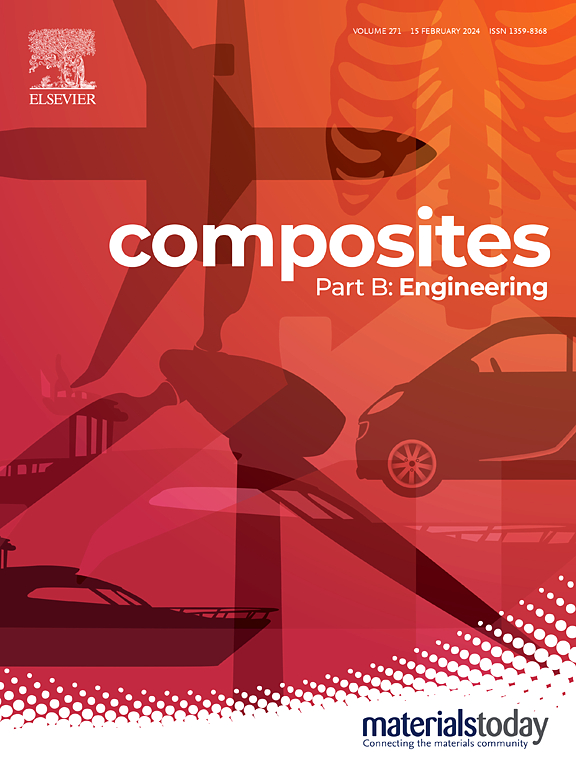聚合物衍生碳化硅陶瓷复合材料的多材料混合增材制造
IF 12.7
1区 材料科学
Q1 ENGINEERING, MULTIDISCIPLINARY
引用次数: 0
摘要
高性能陶瓷的多材料化、多结构化、多功能化在特种工业、生物医药、微电子、航空航天等领域呈现出越来越广泛的应用和需求。现有的陶瓷多材料增材制造技术大多采用单一工艺方法,在材料成分体系、界面调制、结构创建和防污措施等方面存在较大的局限性。提出了一种聚合物衍生陶瓷(PDC)多材料复合增材成形技术,可制备表面无变形、无损伤、无裂纹的多材料SiC陶瓷部件。制备了不同固含量的高粘度聚碳硅烷(PCS)浆料和低粘度氧化铝(Al2O3)/PCS/碳化硅晶须(SiCw)复合浆料,分别用于立体光刻光固化(SLA)和材料挤压(ME)复合工艺。分析了不同使用材料的固化特性,建立了准确的固化特性预测模型。陶化工艺完成后,成功制备了单材料纯SiC陶瓷和多材料SiC陶瓷抗弯试样,后者表现出比前者更优异的抗弯性能。此外,设计了多种多材料模型,重点研究复合过程中水平方向和垂直方向界面的结合质量和微观形貌。揭示了多材料界面“交错层”的生成机理和多材料组分热解微变形的原理。结果表明,该技术可生产出精度高、界面集成度好、缺陷少的多材料聚合物衍生陶瓷元件。自主研发的新型多材料陶瓷混合增材制造系统和软件的高相容性也显示了打印复杂结构的多材料功能聚合物衍生陶瓷的巨大潜力。本文章由计算机程序翻译,如有差异,请以英文原文为准。
Multi-material hybrid additive manufacturing of polymer-derived SiC ceramic composites
Multi-materialization, multi-structuring and multi-functionalization of high-performance ceramics present an increasingly wide range and demand in the fields of special industries, biomedicine, microelectronics, aerospace. Most of the existing multi-material additive manufacturing technologies for ceramics use single-process methods, which have large limitations in the material constituent system, interface modulation, structure creation and anti-fouling measures. This paper presents a multi-material hybrid additive forming technique for polymer-derived ceramics (PDC) to fabricate multi-material SiC ceramic components with surface free of deformation, damage and cracks. High-viscosity polycarbosilane (PCS) pastes with different solid contents and low-viscosity alumina (Al2O3)/PCS/silicon carbide whisker (SiCw) composite slurries were prepared for the stereolithographic light curing (SLA) and material extrusion (ME) compound processes, respectively. The curing behaviors of the different used materials were analyzed and an accurate prediction model of the curing characteristics was established. After the ceramization process, single-material pure SiC ceramics and multi-material SiC ceramics flexural test specimens were successfully obtained, and the latter showed more excellent flexural properties than the former. In addition, a variety of multi-material models were designed to focus on the bonding quality and microscopic morphology of the interfaces in the horizontal and vertical directions under the compound process. The generation mechanism of “staggered layer” at the multi-material interface and the principle of pyrolytic micro-deformation of multi-material components were revealed. The results show that the technique can produce multi-material polymer-derived ceramic components with high precision, excellent interfacial integration and less defects. The high compatibility of the self-developed novel multi-material ceramic hybrid additive manufacturing system and software also demonstrates the great potential of printing multi-material functional polymer-derived ceramics with complex structures.
求助全文
通过发布文献求助,成功后即可免费获取论文全文。
去求助
来源期刊

Composites Part B: Engineering
工程技术-材料科学:复合
CiteScore
24.40
自引率
11.50%
发文量
784
审稿时长
21 days
期刊介绍:
Composites Part B: Engineering is a journal that publishes impactful research of high quality on composite materials. This research is supported by fundamental mechanics and materials science and engineering approaches. The targeted research can cover a wide range of length scales, ranging from nano to micro and meso, and even to the full product and structure level. The journal specifically focuses on engineering applications that involve high performance composites. These applications can range from low volume and high cost to high volume and low cost composite development.
The main goal of the journal is to provide a platform for the prompt publication of original and high quality research. The emphasis is on design, development, modeling, validation, and manufacturing of engineering details and concepts. The journal welcomes both basic research papers and proposals for review articles. Authors are encouraged to address challenges across various application areas. These areas include, but are not limited to, aerospace, automotive, and other surface transportation. The journal also covers energy-related applications, with a focus on renewable energy. Other application areas include infrastructure, off-shore and maritime projects, health care technology, and recreational products.
 求助内容:
求助内容: 应助结果提醒方式:
应助结果提醒方式:


